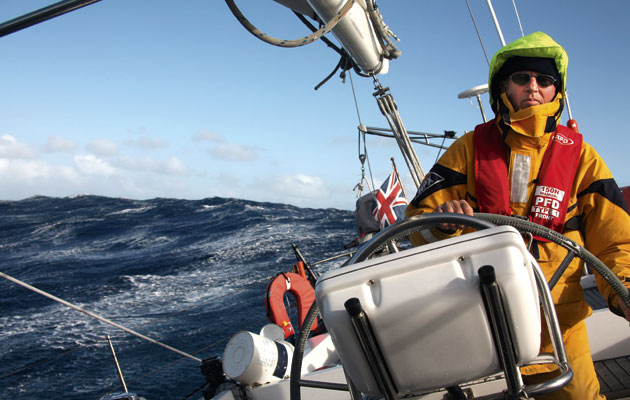James Stevens explains which skills are best to perfect while you have plenty of time to do so. This week, setting storm sails
Setting storm sails

James Stevens, author of the Yachtmaster Handbook, spent 10 of his 23 years at the RYA as Training Manager and Yachtmaster Chief Examiner
This really does need to be practised in harbour because there are several things that can go wrong and you don’t want to be sorting them out in a gale.
A trysail is a small mainsail, high cut at the tack, which allows you to make progress to windward in strong winds. It is an improvement on a deep-reefed main because it has a short luff and comparatively long foot keeping the centre of effort aft and lowering the windage aloft.
If you can safely continue your passage downwind in a gale, forget the trysail and use a jib.
Most trysails use the same mast track as the mainsail, assuming the mainsail luff has sliders, which means the gate has to be quite high to stack all the main sliders below. This allows the trysail sliders to be put through the gate above the main. It is quite a tricky job with the yacht alongside, never mind at sea where you will need to be clipped on at the mast and preferably have an assistant to stop the clew of the trysail lashing around on the deck.
You will probably have to introduce the slides into the gate starting with the head of the trysail. Once they are all in you need a strop from the tack to the gooseneck. Again it’s worth working this out, and having a dedicated piece of rope the right length, before the gale arrives.
Some yachts have a separate track for the trysail running parallel to the main track. This allows you to have the trysail bent on and ready to go well before you need it.

I prefer the clew on the boom as I can use the outhaul to flatten the sail, work to windward, and depower with the mainsheet if needed
Traditionally a trysail is sheeted to the quarters of the yacht, the boom having been lashed down. I’ve found it very difficult to get a flat sail and sheet in hard with a sheet led to the aft cleats – and when you are trying to sail to windward you need a flat sail. I therefore prefer to lash the clew to the boom – harder to do in strong winds but a much better sail shape and easy to adjust with the mainsheet when you get a really strong gust and need to spill some wind. It means the whole sail is slightly further up the mast.
Having worked out the system, keep the clew and tack strops attached to the sail in the bag, as you don’t want to be rooting around in the locker for the right bit of rope.

With a single forestay I need to unbend the genoa to slide my storm jib’s bolt rope into the headfoil
Deep-furled genoas are too full so, if you need to get to windward, you need a storm jib. On a cutter rig, simply use the inner forestay. On a sloop-rigged yacht with a furling genoa – and that’s most of us – setting a storm jib is tricky. Mine has a bolt rope so I need to drop the genoa then hoist the storm jib. If you inherited an old storm jib with piston hanks, it’ll be no use to you if your boat has a furling genoa with a headfoil.

It won’t be easy but, having ironed out all the glitches, I know how to set storm canvas
So what’s your plan? Can you generate enough luff tension to leave it loose luffed? Probably not. There are systems that allow you to hoist a storm jib over the furled genoa, so maybe that’s the answer? What about a removable inner forestay? You’ve time to think now, you won’t with a storm barrelling in.
Video of the Week
Watch UK Halseys video on using storm sails
Adventure: guide to sailing in storms
Award-winning sailor and expedition leader Bob Shepton regularly sails some of the most storm-swept latitudes in the world. Not bad…
Heavy weather sailing: preparing for extreme conditions
Alastair Buchan and other expert ocean cruisers explain how best to prepare when you’ve been ‘caught out’ and end up…
Yacht caught out in Force 10 storm
Passage from Channel Islands to Isles of Scilly ends in rescue








